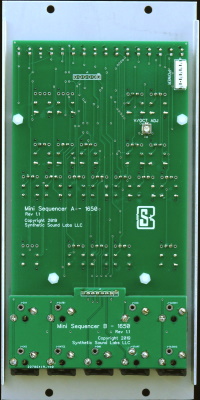Description
An upgraded version of our popular 1651 with greatly improved features. A collaboration with our friends at Division-6.
Feature enhancements over the 1650 include:
- 7 sequence memories
- 5 song memories (string sequences together)
- SLUR- change pitch between steps without firing gate
- Variable gate timing (including ratcheting)
- ACC can be set to drop or not drop between steps, or follow gate timing for that step
- Auto-advance step when programming
- Live transpose (use the keyboard to shift entire sequence up or down while running)
- Live edit (buttons you push while running get saved to the sequence)
- 1X mode (disable to use XP IN as a reset without requiring an external gate mixer)
- Clock out (use ACC out jack to output clock if using internal clock)
The 1651 gives you standard CV and pulse out, plus an ACC out (Accent? Accessory?) Use the ACC output to open up a filter, enable a glide, trigger a drum, or whatever you can think of.
It has its own internal clock to get you up and running in a hurry, but you can connect an external clock if you need greater control of tempo or want to sync with other devices.
The module can store up to 5 songs of 16 sequences each, and 7 sequences of up to 16 steps each. Wow!
Inputs
- CLOCK IN (External clock input)
- START IN (Expansion input; Starts sequencer back at step 1. Use for daisy-chaining multiple units)
Outputs
- END OUT (Sends pulse when sequencer goes past last step. Use for daisy-chaining multiple units)
- ACC OUT (Can be programmed on or off in each sequence step)
- PULSE OUT
- CV OUT
Features
- CV OUT covers 5 octaves
- Sequences can be set to any length up to 16 steps by using LOOP feature
- Setting a step to REST holds previous pitch and doesn’t fire PULSE out
- Setting a step to SLUR changes to the new CV and doesn’t fire the PULSE out
- In Standby mode, sequencer can be used as a tiny keyboard without altering programmed sequences
- 7 sequence memories with up to 16 steps per sequence.
- 5 song memories string up to 16 sequences together
- Live transpose
- Much more…
Cascading
You can also cascade multiple 1651 ‘s to create longer, more complex and syncopated patterns. Why would you need more than one sequencer?
- More sequencers = more steps
- Use one for playing notes and the other for transposing those notes
- Can be used as a clock divider
- Run in parallel for multiple CVs / triggers
The two sequencers will run completely independently, or you can daisy-chain them using the START IN / END OUT jacks to create sequences of any length.










Reviews
There are no reviews yet